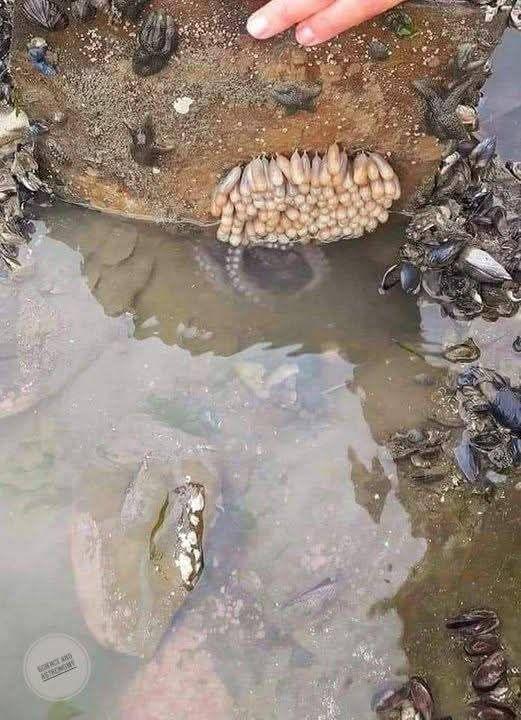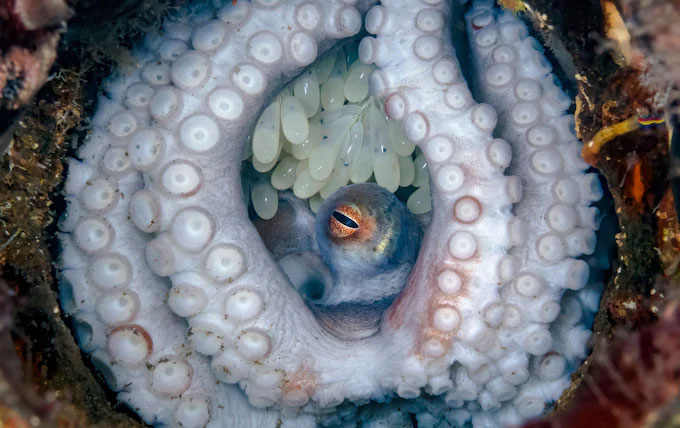Let Her Finish Her Journey: The Silent Devotion of the Mother Octopus

Let Her Finish Her Journey: The Silent Devotion of the Mother Octopus
On the quiet shores where the ocean kisses the rocks, life unfolds in ways most of us never see. Beneath the tide pools and hidden in rocky crevices, a delicate story plays out — one of sacrifice, instinct, and silent devotion. It’s the story of a mother octopus.
To many beachgoers or divers, a motionless octopus hidden beneath a rock might seem like an easy catch — a slow-moving, passive creature ripe for capture. But behind that stillness lies one of nature’s most powerful acts of maternal care. What might seem lifeless is, in fact, a mother making the ultimate sacrifice — giving her life so that others may begin theirs.
This article explores the biology, behavior, and heartbreak of the female octopus during her final journey, and why we must urgently spread awareness to protect her and her offspring. Her fate is written the moment she lays her eggs. The least we can do is let her finish her journey.
The Lifecycle of the Octopus
Octopuses are extraordinary creatures. With over 300 known species, these invertebrates are known for their intelligence, camouflage abilities, and unique physiology. But one of the most fascinating and heartbreaking aspects of their life cycle is how they reproduce.
A female octopus lays eggs only once in her life. Depending on the species, she may lay thousands — even hundreds of thousands — of tiny, rice-sized eggs, attaching them carefully to the walls of her den. Once her eggs are secured, she becomes a full-time mother, devoting herself entirely to the survival of her young.
From that moment forward, she stops eating. Her energy is no longer reserved for survival, but solely for motherhood. She spends weeks — sometimes months — protecting the eggs, keeping them clean, aerated, and safe from predators. This period of incubation can last anywhere from one to six months, depending on the species and water temperature.
During this time, her body slowly weakens. Her muscles shrink. Her skin fades. Her energy drains. But she never leaves the den.
The Final Act of Love
When the time finally comes, the eggs begin to hatch — usually around late August or early September. The mother’s last act is to gently guide her babies into the open ocean. They will be on their own from the very first moment of life. No mother, no protection. Just instinct.
Then, her task complete, the mother dies.
This is not a dramatic death filled with panic or resistance. It is a quiet, inevitable end. She was born to live only long enough to ensure that new life begins. Biologists call this “semelparity” — a biological term for species that reproduce only once before death.
It is a story of immense sacrifice — and one most of us overlook.

A Still Creature Isn’t a Dead One
Unfortunately, many people who come across this spectacle during low tide or while diving don’t realize what they’re seeing. A mother octopus looks still, almost lifeless. She doesn’t move. She doesn’t fight. To an untrained eye, she may appear sick, dying, or already dead.
This is where the damage begins.
Fishermen, explorers, or even curious tourists may try to catch her. Some reach into her den. Some disturb or steal the eggs. Others simply take the octopus, assuming she’s easy prey. In doing so, they destroy a vital and irreplaceable process in nature — one that is already so fragile.
Without the mother, the eggs will not survive.
They will not hatch. The next generation will be lost.
What may seem like a harmless interaction becomes a direct blow to the survival of a species already vulnerable to habitat loss, pollution, and overfishing.
The Intelligence and Emotion of Octopuses
Octopuses are not like other sea creatures. Their intelligence has been well-documented by marine biologists and researchers. They can solve puzzles, open jars, escape enclosures, and even show signs of curiosity and memory.
To many scientists, octopuses are emotional creatures. Though they are very different from mammals, their nervous systems are complex. They have neurons not just in their brains, but throughout their arms — which some describe as having “independent minds.”
So when a mother octopus tends to her eggs, she’s not just following instinct
Her slow movements. The way she gently blows water over her eggs to keep them clean. Her refusal to leave, even when starving. These are not passive behaviors. They are active decisions made by a highly intelligent animal who knows what’s at stake.
How Human Behavior Disrupts This Cycle
The biggest threat to this quiet story is human interference.
-
Tide Pool Exploration: During low tide, beachgoers often explore tide pools. While this can be a beautiful way to engage with marine life, it’s easy to disturb nesting sites unknowingly. Rocks are overturned, dens are poked, and eggs are exposed to air and sunlight.
-
Fishing and Hunting: Some people specifically look for octopuses to catch and eat. They may see the mother’s stillness as weakness. They remove her from her nest or worse — kill her on the spot.
-
Egg Theft: In some cultures or markets, octopus eggs are considered delicacies. Poachers and fishermen may steal egg clusters to sell, unaware that they are killing thousands of lives in one act.
-
Pollution and Habitat Loss: Coastal development, oil spills, and plastic waste have destroyed or contaminated many of the rocky habitats where octopuses nest. Even light pollution from urban areas disrupts natural rhythms in coastal waters.
-
Ignorance: Perhaps the most dangerous threat is simply not knowing. People do harm because they don’t realize what they’re seeing.

Why Her Story Matters
In the larger scope of global environmental concerns, it may seem small — one octopus, one nest, one patch of rocky shore.
But her story represents something much bigger.
She symbolizes the invisible threads of the natural world — the unseen sacrifices that keep life going. Her existence reminds us that every creature, no matter how small or hidden, plays a role in the larger balance of life.
The octopus mother gives everything so that others can live. And she asks for nothing in return. No applause. No recognition. Just the chance to complete the cycle.
Letting her finish her journey is not just an act of compassion — it’s an act of respect.
What You Can Do
Whether you’re a diver, a fisher, or just someone who enjoys the beach, you have a role to play. Here are ways you can help:
1. Do Not Touch or Disturb
If you see octopus eggs or a still octopus in a den, do not touch, poke, or try to remove her. Take a photo from a distance if you like — but do not interfere.
2. Spread the Word
Many people simply don’t know the story. Share it. Tell others. Post it on social media. If even one person learns to recognize the signs, it could save thousands of baby octopuses.
3. Support Conservation Efforts
Look for marine protection programs or local organizations that work to preserve coastal ecosystems. Your donations or volunteer efforts can make a big difference.
4. Report Poaching or Disturbance
If you see someone collecting eggs or disturbing a nesting site, report it to local wildlife authorities. In some places, this is illegal and punishable by fines.
5. Be Mindful of Tides
Plan your visits to beaches or tide pools with care. Avoid overturning rocks or sticking hands into underwater crevices. Remember that these are homes, not playgrounds.

A Final Word: Let Her Finish
In a world that moves fast, it’s easy to overlook the slow and silent sacrifices happening in nature. But sometimes, the most powerful stories are the ones we nearly miss.
The next time you’re walking along the coast and see something strange beneath the rocks, pause.
Don’t touch.
Don’t remove.
Don’t disturb.
Let her finish her journey. Let the cycle continue. Let life find a way, just as it always has — quietly, courageously, and with more grace than we often deserve.











